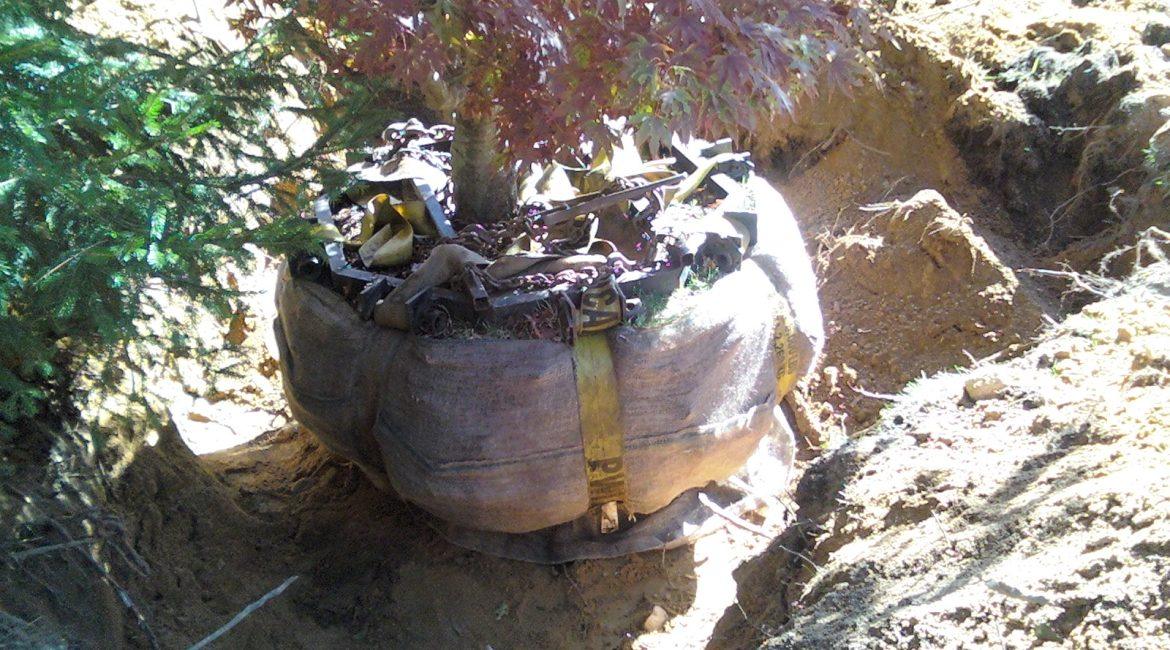Okay, so I know that if your anything like me, when spring rolls in each year, you start thinking about planting. Planting seeds, veggies, bulbs, and hopefully planting trees. So do you have plans this season to plant any new trees? Let’s talk about it!
Step 1. Plan Out Your Planting Site
Your tree will grow.
Do not plant your tree where it will interfere with buildings, overhead utility lines,
pavement, or intersection sightlines as it gets bigger.
Make sure your planting spot is at least. . .
- 3 feet from pavement or fencing on all sides
- 15 feet from buildings or other trees
25 feet from overhead electric wires, if your tree will grow taller than 30 feet.Check Below Ground
Before you dig, call the underground utility locating service in your area to be sure that there are no buried utilities where you want to plant.
Here in Kansas, the number to call is 811 to reach the Call Before You Dig hotline.
At least 72 hours in advance of planting, call the underground utility locating service in your area to be sure that there are no buried utilities where you want to plant. Most services will mark utilities (e.g., electric, cable, gas) for free.
Step 2. Moving the Tree
Carry your tree by its root package (ball or container)—not the trunk! Steady it by holding the lowest part of the trunk.Protect the trunk while moving your tree. Even a small wound on a young tree can cause permanent damage.
Step 3. Remove Trunk and Branch Packaging
Remove trunk wrap, twine around the branches, and labels. Leave any root packaging in place for now.
Step 4. Prune Critical Branches Only!
Prune only branches that are broken or dead. You may also remove competing leaders, if present. Most trees should have one central leader. If there are two or more leaders, choose which one you want to remain and remove the other(s).
Minimize pruning at the time of planting! Trees need as many leaves as possible to recover from transplant shock (leaves produce the tree’s food).
Step 5. Find the Main Root System, and Remove Excess Soil
Remove soil from the top of the root ball until the top of the main root system is exposed. There should be several roots at least as big around as a pencil extending in opposite directions from the trunk. You may have to remove 2-4 inches of soil before finding the main roots.

Remove the top of the root ball packaging. Cut any twine from around the trunk taking care not to nick the bark. Then bend the wire basket back off the top of the ball. Remove soil from the top of the root ball until the main root system is found. You may have to cut some of the wire. Leave the rest of the wire basket in place until the tree is put in the ground.
Step 6. Remove Problem Roots
Remove all small roots above the main root system with a hand pruner.
Examine the main root system for roots that extend out but then turn to the side or back towards the trunk. Prune these roots at the point where they turn. If left these circling roots can later become a big problem for the tree.
Step 7. Dig the Hole
Don’t put a $100 tree in a $10 hole! The dimensions of the hole are very important in determining the survival of your tree. Dig the hole ONLY as deep as the root system (NO deeper!).
Measure the height of the remaining root ball. This is exactly how deep you should dig the hole.
Measure the approximate width of the root ball or root system. Multiply this by 2, or if your soil is hard (clay or compacted), by at least 3. This is how wide you should dig the hole. DON”T GUESS!
HOLE DEPTH = height of root ball
HOLE WIDTH = width of root ball 2 or 3x
Step 8. Put Tree in the Hole
If the tree has a heavy root ball, slide it into the hole, and straighten the trunk. Be very careful at this point to not let the root ball fall apart.
Step 9. Remove Root Ball Packaging
(for Balled-and-burlapped trees)
Balled-and-burlapped trees up to this point still have most of the packaging intact: Without loosening the root ball, cut, peel back, and remove as much of the wire basket and burlap as possible (at least the top third).
A root ball should remain a root ball. If it starts to fall apart as you take off the
wire and burlap, backfill the hole with enough soil to stabilize it. Then carefully remove the wire and burlap, and backfill as you go to keep the root ball intact.
Step 10. Backfill With the Same Soil
Make sure the trunk is straight. Put the original soil back in the hole, breaking up large clods, and working it in with your hands or a shovel.
Step 11. Water.
Water the root ball and entire backfilled area. Larger trees should be watered in as the hole is backfilled. Back fill hole about half way and then water in and let the water and soil settle in around the root ball.
Step 12. Mulch
Put a 2-4 inch layer of mulch over the backfilled area. Pull mulch away from the trunk so that none touches the bark. There should never be more than 4 inches of mulch over the roots. Too much can prevent the roots from getting necessary oxygen.
To Stake or Not to Stake?
Some trees need to be staked to remain standing straight in their new planting site. Stake only if the root ball is unstable or the trunk is bending. Use wide nylon, canvas straps, or nylon stockings wrapped around one side of the trunk. The tree should not be tied tightly.
If the root ball is unstable, use 1-3 stakes attached LOW on the trunk. If the trunk is bending, use 1 stake attached HIGHER (at least 6 inches below the first set of
branches).





